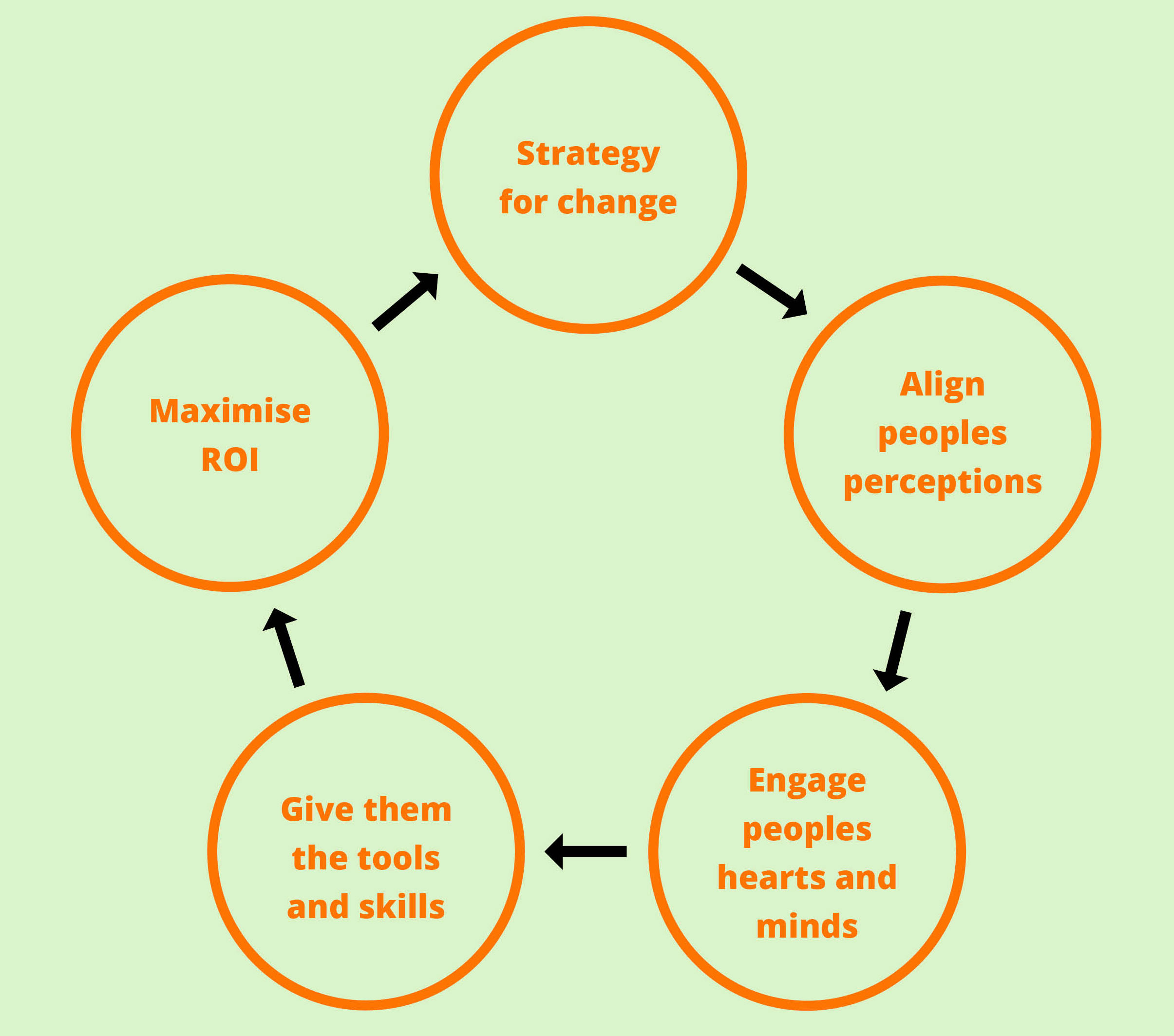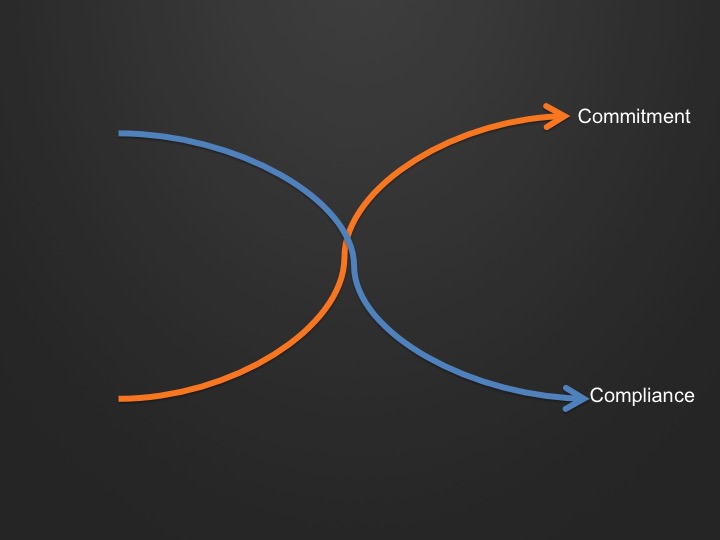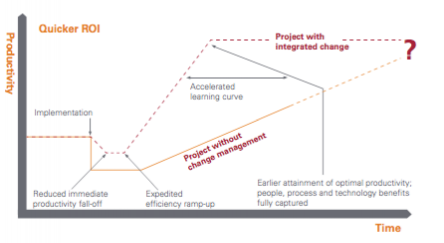For organisations, change is not required just to improve effectiveness. It’s often required for an organisation’s survival. In this guide, I’ll define What is Change Management and how to create change for your organisation.
Consider that just one app can change an entire business model. That the rate and frequency of change continues to speed up in almost every market around the world. In one study by KPMG, 76 percent of CEOs said that their companies are changing, or have just changed the entire way they operate their business.
Yes, all this change can make an organisation a dynamic and vibrant place to work. But it does present challenges for the people and teams who need leadership and guidance. If you are to realise the benefits of making changes you need to understand what change management is, and how to create it.

In this guide, I’ll look at the what change management is. The common approaches used in getting people to change. You’ll also discover why people change. As well as the processes and steps you can take to create change while avoiding the common pitfalls and obstacles.
What is change management: a definition
 Change management is the application of processes, methods, body of knowledge, skills and experience to bring about the people side of change and therefore optimise the benefits of an initiative
Change management is the application of processes, methods, body of knowledge, skills and experience to bring about the people side of change and therefore optimise the benefits of an initiative
Change management as a practice is more and more becoming a part of mainstream business. Used in decision-making, delivery and benefits realisation.
Used as a means to improve communications, get wider community support or buy-in for projects. As well as gather useful data and ideas. Enhance public sector or corporate reputation. And provide for more sustainable benefits realisation.
Change management is never about the technology. Nor the structure change, or business processes, or strategy or culture. Said another way, change management isn’t about the content, it’s about the context.At it’s core, change management is about getting people to change their behaviour.
Change management is a lot like project management 30 or so years ago. Back then line managers ran projects alongside their day jobs, but not too well.
Later executives realised that projects are discreet pieces of work. And work that benefits from project managers as specialists. Change management is going through a similar path. Becoming a specialist function in its own right.
 Investment in change management will have a many benefits. For the organisation as well as for the people receiving the change.
Investment in change management will have a many benefits. For the organisation as well as for the people receiving the change.
5 step cycle of change management

The often cited statistic is that 75 per cent of change initiatives fail. Whether that’s true or not is debatable. What we can say is that there are many, many issues that get in the way of successful change.
These issues include politics, inertia, conflicting goals, poor communication or just plain bad management. Despite the best efforts, even the smartest people fail to achieve lasting and meaningful benefits.
But the evidence is that not all change initiatives fall short. Successful transformations have one thing in common: effective change management.
Who is Change Management for?
Change Management is for any organisation engaged in a change initiative where the benefits depend on people changing their behaviour.
An example:
Let’s take the implementation of a CRM system. Such a system requires the sales people as “users” to learn and use this new system. As opposed to the old system and/or spreadsheets they were likely using before. A project like this (and from experience) definitely needs change management applied.
Now, if you take the case of a server upgrade where the benefit of the change results from increased throughput ofwidgets. In case like this no one needs to change what they’re doing to get the benefits. In pure technical initiatives like this change management is not required.
The Types of projects that benefit from an organised approach to change management are:
- Transformation
- IT and data enabled services
- Shared Services
- Mergers & Acquisitions
- Growth initiatives

What is the Difference between Change Management and Project Management
A definition of project management

Project management is the application of knowledge, skills, tools, and techniques to project activities in order to meet or exceed stakeholder needs and expectations from a project.
What project managers do?
Project Managers would be familiar with the Project Management Body of Knowledge (PMBOK), which refers to the nine knowledge areas below:
- 1. Project Integration Management** – ensuring the various project elements are properly coordinated, plan development and execution, and integrated change control
- 2. Project Scope Management – ensuring the project includes all the work required to complete the project successfully, incorporating initiation, definition and scope change control
- 3. Project Time Management – ensuring timely completion of the project, including activity definition, sequencing, forecasting and scheduling
- 4. Project Cost Management – ensuring the project is completed within the approved budget, including cost estimating, budgeting and control
- 5. Project Quality Management – ensuring the project satisfies the need for which it was undertaken, including quality assurance and control
- 6. Project Human Resource Management** – making the most effective use of the people involved with the project, including organisational planning, staff acquisition and team development
- 7. Project Communications Management** – ensuring timely and appropriate generation, collection, dissemination, store and ultimate disposition of project information
- 8. Project Risk Management** – identifying, analysing and responding to project risks, including risk identification, analysis, response planning and control; and
- 9. Project Procurement Management – acquiring goods and services from outside the performing organisation, including solicitation, source selection, and control administration
What change managers do?
Change Management focuses on people, processes and culture. While it impacts each of the nine knowledge areas in some way, it has the greatest impact on those areas highlighted with a star** above (numbers 1,6,7,8).
Change management activities are best integrated with the wider project plan. Be sure to involve the project team rather than handle change as a separate stream of work. This ensures alignment of change targets, tactics, messages and behaviours with wider project activities.
In summary
Change management involves bringing people from the “current state” to the “future state”. Said another way, the changes course from the “default future” to the “created future”.
Project management brings about the technical aspects of the initiative.
Change management brings about the organisational, people and cultural aspects of the change.
How much change management is needed?
Not all projects need large efforts of change management.
At one end of the spectrum there is a pure technical change that requires no people change at all. For example, replacing a new server.
At the other end is a project where the entire benefits come from people changing their ways of working.

Participation can be broadly categorised into the following
TACTICAL Change
versus STRATEGIC Change
TACTICAL CHANGE

Definition of Tactical Change:
One impacting a relative small number of stakeholders. Usually within one department or division. With short implementation timeframes and lower risk of failure.
These are usually delivered within existing operational capacity.
Other Indicators:
- a successfully completed pilot with the new initiative relating to wider roll out
- operational activities that occur on a regular, predictable basis
- introduction of a new product that is similar to existing.
STRATEGIC CHANGE

Definition of Strategic Change:
One affecting a large number of stakeholders. Requiring coordination over many departments which increases risk of failure.
Requires a specialist project team as existing operational capacity would not cope.
Other Indicators:
- a trial or pilot conducted to determine strategy for a wider roll out
- a project or initiative in response to a competitive threat
- a project or initiative in response to a competitive threat
- projects falling under a broader program of work
Levels of change management participation

A tactical project requires at least that stakeholders are “informed”.
While a strategic project with many stakeholders needs different levels of participation and engagement.
- 1. Inform To provide the stakeholders with balanced and objective information to assist them in understanding the problem, alternatives, opportunities and/or solutions.
- 2. ConsultTo obtain stakeholder feedback for decision-makers on analysis, alternatives and/or decisions.
- 3. InvolveTo work directly with the stakeholders throughout the process to ensure that public concerns and aspirations are consistently understood and considered in decision making processes.
- 4. CollaborateTo partner with the stakeholders in each aspect of the decision including the development of alternatives and the identification of the preferred solution.
- 5. EmpowerTo place final decision-making in the hands of the stakeholders.
Drivers of change: Ready, Willing and Able
There are three drivers of change: ensuring your users are Ready, Willing and Able. Focusing on these three drivers will enable you to realise the benefits in quick time.
- READY = User adoption of change
- WILLING = User adoption of change
- ABLE = User adoption of change
Ready
Change Readiness is the foundation for business ownership as the project transitions from implementation, completion and handover.
Assessing and planning for readiness begins at the project launch, and completed before implementation. Any project involving a change to ways of working.
The factors to assess for readiness are:
- the perception of the need for change,
- how much (or little) support the change is likely to get from stakeholders,
- what the driving and blocking forces might be to achieving project success, and
- leaderships ability to manage the change.

Not all stakeholders will recognise and accept the need for change. A readiness assessment will help you understand the stakeholders ability to manage change, levels of commitment to change, the strength and extent of barriers to changes in the organisation’s culture and processes.
Change readiness assessments are valuable because they help clarify where an initiative might run into problems. They help identify possible barriers, enablers and risks.
With problem areas known you can then develop change management plans to help people get ready for change.
Sample change readiness questions to ask:
- to what extent people subscribe to the change initiative vision;
- how much commitment to the planned initiative exists;
- do people currently have the skills and capabilities required for the new ways of working; what is the gap?;
- the need for any changes in leadership behaviour and activity;
- the degree of support that exists for the changes throughout the organisation and from other stakeholders;
- the barriers to and drivers of change;
- the issues and concerns to address to help the change process.
HOW TO ASSESS CHANGE READINESS
Assessing change readiness is straight forward: you must ask and listen for what is going on.
In practice you have have to deal with the organisational noise. To avoid survey fatigue a range of assessment tools are best.
Here are some ideas:
- Interview one-on-one a cross-section of people. Segment by stakeholder, function and level
- Run focus groups, segmented by stakeholder, function and level
- Analyse existing survey data and other appropriate existing studies or documentation;
- Targeted online surveys
- Change readiness questionnaires (see Buy-in Index)
- Conduct a risk assessment of the change
- Analyse previous projects for a change history assessment
- Conduct change readiness workshops
- Assessing change readiness is not a one-off process. Check-in as the project develops.


Willing
Once people are ready for the change doesn’t mean they will use the new system or way of working. Unless they’re willing (assuming they have the skills, which we’ll discuss next).
Willingness has outcomes in utilisation. That is the degree people use the new system or ways of working.
An example:
Consider a hypothetical case of a CRM implementation. The users are ready and have the skills. But they still maintain their excel spreadsheets on the side and seldom enter call reports of any substantive content.
COMMITMENT OVER COMPLIANCE
The salespeople are being compliant to the extent they have to, but showing no commitment. Or said another way, they’re not willing.
How do you drive willingness and commitment?
You drive willingness through communication, leadership alignment and engagement through active participation.
COMMUNICATIONS AND ENGAGEMENT APPROACHES
The aim is to develop and maintain support for the change from those who are both involved and affected by it.
Engage peoples hearts and minds. Don’t approach them like an analyst’s presentation with figures and graphs.
Instead like a book written in human language, telling people where we are, where we wanted to go, and how we were going to get there.

There are four types of information to communicate to stakeholders:
- Why the change is necessary.
- How the plan is progressing
- Specific examples of success, failure, and people’s responses.
- General related information – for example, what is reported in the press, comments from the leadership team, or suggestions.
There are many models of change (and I’ll cover them in later guides) but to focus your communications and engagement plans, think about these four steps:
- awareness and understanding,
- buy-in,
- adoption
- usage
Use these basic concepts to get an understanding of where you are in the process.

Able
ASK YOURSELF THIS QUESTION: if you put a gun to the users head, could they do the job?
It’s a provocative question, but if the answer is yes, then you don’t have a skills problem.
You have either a readiness or willingness problem.
If the answer is no, then you have a skills problem.
Skills and knowledge required to the job are more than a training session and a handout. It also involves ensuring people reach a level of skill that brings the benefits.
But The application of skills and knowledge is not enough. The surrounding organisational capability must also support the new ways of working.
CONDUCT A SKILLS AUDIT
Complete a skills audit to determine how much training and capability uplift people need. Assess the current skill set of the various user groups and compare he results to the skills required in the new operating model.
Skills Audits are generally only conducted for Strategic Change Initiatives.
The skills audited will depend on the new business operating model.
Assess the technical and procedural skills users will need to function in the new operating model. Also assess the “softer” skills that are important for the role. For example, sales skills, customer service and telephone technique, are often neglected.

Some skills areas that may be assessed:
- 1. Product Knowledge – consider the various products and services users should be familiar with;
- 2. Process Knowledge – new or changed processes, existing processes for new users, and processes requiring standardisation and reinforcement;
- 3. Policy and Business Rule Knowledge – new or changed policies and business rules;
- 4. System Knowledge – systems and software users will be required to use;
- 5. Soft Skills – telephone techniques, qualifying needs, complaints handling, negotiation, follow up, sales skills and so on.
 HOW TO IMPROVE SKILLS: THE FIVE E’s OF EDUCATION
HOW TO IMPROVE SKILLS: THE FIVE E’s OF EDUCATION
There are many ways for people to engage with information. But what produces the best results?
Explanations and Examples form the foundation of education. They build on current models and knowledge bases, enabling new ones to be created.
What leverages the learning Experience above the level you might Expect to reach is the wedge of Exploration. When individuals are free to Explore, they create a powerful personal relationship with the information. They search the unknown, encounter the unexpected, and uncover surprises!
Most importantly – as a result, they own the information. This is very powerful – enabling them to ‘say it’ (whatever ‘it’ is) to each other, than be told it by the Facilitator, Design or an SME! The internalised information has richer connotations and is able to be applied in a more useful ways in solution design.










